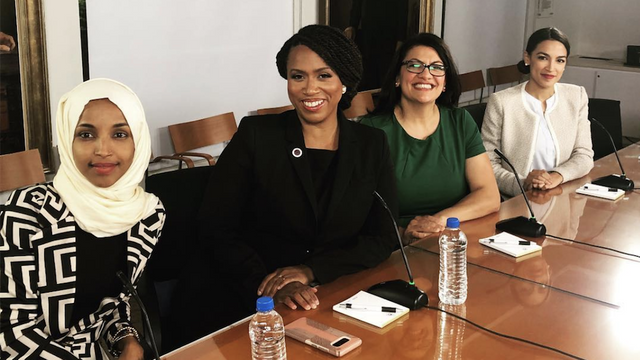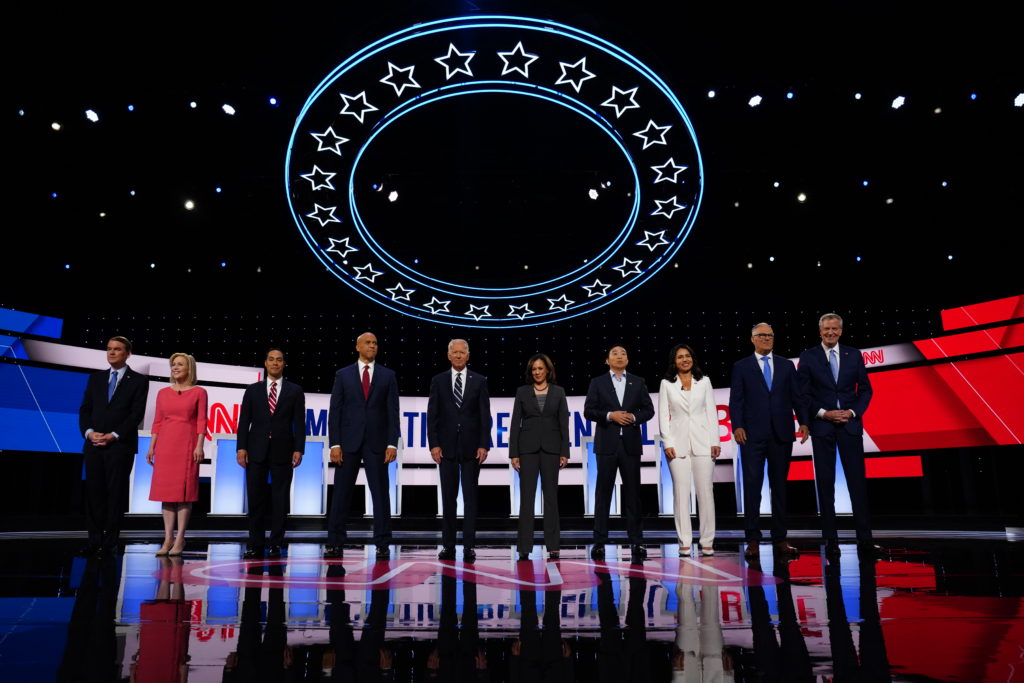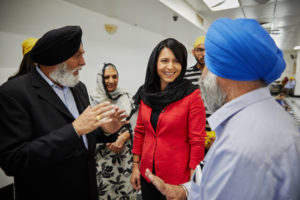8510 people reached on Lassi with Lavina FB page – 483 engagements – 21 Likes – 8 comments
Liked by Chandini Dayal, Nandini Godbole, Rajendran Po, Jamie Cid & 6 others on Lassi with Lavina FB page

“Go Back to Your Country!”- The Darker Side of Immigration
There is a co-relation between hate speech and hate violence
[dropcap]T[/dropcap]he world was astounded to hear the President of America tell four American Congresswomen to go back to their countries. Representatives Alexandria Ocasio-Cortez of New York, Ayanna S. Pressley of Massachusetts and Rashida Tlaib of Michigan were all born in America while Ilhan Omar of Minnesota is a refugee from Somalia who came into America as a child, and grew up as a naturalized citizen. The president tweeted to them “go back and help fix the totally broken and crime infested places from which they came. Then come back and show us how it is done.”
Needless to point out, all four representatives are women of color. Indeed, at a Trump rally in North Carolina, the crowds chanted ‘Send her back!’, referring to Rep. Ilhan Omar whom the president had identified as an Al-Qaeda sympathizer.
When first-term Congresswomen, who walk the corridors of power and help create legislative policy, can themselves be attacked and told to go back, then what hope is there for ordinary immigrants?
When the person in the highest office in the land hurls the oldest taunt in the dictionary against immigrants, it really ups the ante on racism. Just a few weeks back Swami Harish Chander Puri, a Hindu priest in Glen Oaks, Queens was assaulted and beaten up near the Shiv Shakti Peeth Temple. According to eyewitnesses, the assailant shouted, “This is my neighborhood” to the priest who was wearing the saffron robes of his faith. Puri had to be rushed to hospital.
“There will be no end to hate violence unless we disrupt and dismantle the racist narratives and policies leading to this violence,” says Lakshmi Sridaran, Co-Director of South Asian Americans Leading Together (SAALT), a national organization that advocates for the civil rights of south Asians in the US. “This should start from the top, but instead the highest levels of government are encouraging this violence.”
SAALT’s Communities on Fire report
[dropcap]T[/dropcap]he SAALT report titled ‘Communities on Fire: Confronting Hate Violence and Xenophobic Political Rhetoric’ written by Dr. Radha Modi of the University of Illinois, Chicago showed the upswing in hate. SAALT documented 213 incidents of hate violence aimed at South Asian, Muslim, Sikh, Hindu, Middle Eastern, and Arab communities in the year following the 2016 presidential election, an increase of 64 percent over the previous year. According to the report, “Perpetrators referenced President Trump, a Trump administration policy, or a Trump campaign slogan in 1 out of every 5 hate incidents.”
Dr. Radha Modi writes, “Despite the recent surge in divisive anti-Muslim political rhetoric and the devastating hate violence targeting South Asian, Muslim, Sikh, Hindu, Middle Eastern, and Arab communities over the past two years, both are products of a decades-long history of political rhetoric and policies steeped in racism, xenophobia, and Islamophobia.”
Be it restaurant workers or taxi drivers, blue collar workers or those in startups, many have tales of routine racist bias by the mainstream. The Sikh community is particularly prone to racist attacks. According to the Sikh Coalition, the nation’s largest Sikh civil rights organization, Sikhs in America remain hundreds of times more likely to experience bigotry, bias or backlash than the average American.
The coalition notes that the first recorded act of hate violence against Sikhs in the US was as far back as 1907 in Bellingham, WA. Hundreds of members of the Asiatic Exclusion League attacked South Asian immigrants, most of whom were Sikhs working in local lumber mills. From 1907 jump to 2001 – the first post-9/11 backlash fatality was Balbir Singh Sodhi, a Sikh-American gas station owner who was shot by a man who, when arrested, called himself a patriot. At the time of his murder, Mr. Sodhi was placing American flags in the landscaping outside of his shop.
In 2012, occurred the deadliest attack on any house of worship in the US – a white supremacist shot and killed 6 worshipers at the Oak Creek gurudwara. In l2018, the FBI released the 2017 hate crime statistics which show that there has been a 243% increase in hate crimes against Sikhs over the last 18 years.
Simran Jeet Singh, who is a professor, has heard the infamous ‘Go Back to Your Country’ chant since he was a child growing up in Texas. He wrote in religionnews.com, “I can’t recall how many times I’ve been told to go back to where I came from. What I do know is that the frequency of these calls has increased in recent years, in part because of what scholars are calling the Trump Effect: the emboldening of people to act and speak on their racist feelings.”
Indeed, according to 2017 data, hate crimes are rising to a point where we are now seeing the second highest increase in hate crimes against Sikhs since 2001 – and these are just the cases that get reported.
[dropcap]S[/dropcap]imran Jeet Singh moved to New York when he was 24 and has worked on issues of race, noticing a correlation between hate speech and hate violence, Yet seven years later, he says: “experts are finding a similar trend: The vitriolic discourse of our current political climate is contributing heavily to the sharp uptick in hate groups and hate violence all across the United States.”

Detroit, Michigan
2019
Colorado Sen. Michael Bennet
New York Sen. Kirsten Gillibrand
Former Housing and Urban Development Secretary Julian Castro
New Jersey Sen. Cory Booker
Former Vice President Joe Biden
California Sen. Kamala Harris
Businessman Andrew Yang
Hawaii Rep. Tulsi Gabbard
Washington Gov. Jay Inslee
New York Mayor Bill de Blasio
[dropcap]A[/dropcap]s America has got more diverse, for the haters there seem to be just many more opportunities to indulge in hate speech and hate violence. Racism has been a fact of life in America but in the past few years has become much more blatant and acceptable.
Asked about the steady rise of the unacceptable becoming acceptable, Mark Reading-Smith, Senior Director of Programs at the Sikh Coalition noted, “ When the president validates bigotry and racism, some Americans will listen and follow. This is not a hypothetical–we saw multiple instances over the past few weeks of other elected officials at the state and local level echoing this rhetoric. Moreover, many of our Sikh colleagues and clients have literally been told “to go back to your country” over the years despite the fact that Sikhs have been an integral part of U.S. society for more than 125 years.”
The FBI has reported a rise in hate crimes for the past three consecutive reporting years. “I can also tell you that our Legal team continues to average approximately one hate-related legal intake every month involving a Sikh community member,” says Reading-Smith. The organization has been pushing law enforcement to better track hate crimes, specifically against Sikhs, for years. After the attack on the Oak Creek, WI gurdwara in 2012, federal law enforcement began more specific tracking in 2015, though it is not mandatory.
Says Reading-Smith, “This is not a political or partisan issue: There is absolutely no place in our political system, on either side of the political aisle, for bigotry or racism from any elected official. This behavior is dangerous and continues to have real life consequences for millions of minorities across the United States.”
[dropcap]T[/dropcap]he silver lining in this dark situation is the willingness of many in power to call out racism when it occurs. As the New York Times noted: “The House, in a stunning rebuke of a sitting president, voted on Tuesday to “strongly condemn” President Trump’s suggestion that four freshman Democratic women of color “go home” — a Twitter broadside described in a Democratic resolution as “racist comments that have legitimized and increased fear and hatred of new Americans.”
Racism of course comes in many shapes and forms, from hurtful remarks to all forms of injustices – economic disparities, educational and financial walls, voter suppression, loss of possibilities for people of color, for people who are different. This is what makes the upcoming presidential elections so crucial as twenty possible contenders take to the stage to try and change the status quo in America.
(This article was first published in India in America, my weekly column in CNBCTV18.)
Related Articles:

Tulsi Gabbard: can she be the next American President?
Indian-Americans Players in the Midterm Elections


7 Comments
Vartika Misra via Facebook
Lassi with Lavina, there’s no justification for behavior.. racism
is everywhere , true that Indians are welcoming ,but Indian have their own big racism thing going on in its society . It’s the mindset where we have to accept people as people first rather than where they are from 😊
AK Jain via Facebook
Himanshu Agarwal – No buddy, Hindus are the only who never took advantage of majority, that’s why we are multicultural and a Muslim became president certain times.
Himanshu Agarwal via Facebook
What i have seen is nobody is perfect.
Every community tries to take advantage of being in majority, which is more of a natural human behaviour. So if you are doing discrimination with someone where you are in majority, you lose the right to protest for discrimination done to you where you are in minority. Go and first fix your people who are discriminating elsewhere and then set an example.
It’s quite an eye-opener. I have it my article too and quotes from some insightful people.
Nandita Godbole via Facebook
I’m using that report in an op-ed
Jamie, sorry to hear that. I thought Indians were generally welcoming and hospitable.
Maybe she felt threatened by you, working on assignments she felt entitled to be given.
Jamie Cid via Facebook
I have to share that while in India, I had someone say that to me, the interesting part, she was an Indian woman, Yale grad, I never understood her anger or why. But for the first time in my life I felt what it was like to be discriminated upon.